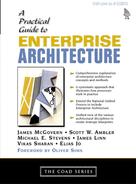0%
114Chapters
0-1Hours read
0kTotal Words
Book Description
In A Practical Guide to Enterprise Architecture, six leading experts present indispensable technical, process, and business insight into every aspect of enterprise architecture. You'll find start-to-finish guidance for architecting effective system, software, and service-oriented architectures; using product lines to streamline enterprise software design; leveraging powerful agile modeling techniques; extending the Unified Process to the full software lifecycle; architecting presentation tiers and user experience; and driving the technical direction of the entire enterprise. For every working architect and every IT professional who wants to become one.
Table of Contents
- Copyright
- The Coad Series
- www.wwisa.org
- About Prentice Hall Professional Technical Reference
- Acknowledgments
- Foreword
- Preface
- Systems Architecture
- Software Architecture
- What Is Software Architecture?
- The Role of a Software Architect
- Why We Need Software Architecture
- The System Stakeholders
- Creating a Software Architecture: An Example
- Architecture Description Languages and UML
- Quality Attributes
- Architectural Viewpoints
- Architectural Styles, Patterns, and Metaphors
- Conclusion
- Service-Oriented Architecture
- Software Product Lines
- Methodology Overview
- Enterprise Unified Process
- Agile Architecture
- Agility in a Nutshell
- Potential Problems with Traditional Approaches to Enterprise Architecture
- An Agile Approach to Architecture
- What Should Agile Architecture Efforts Produce?
- Agile Architecture at Canaxia
- Introducing an Agile Approach into Your Organization
- Are Other Architecture Approaches Agile?
- Potential Problems with an Agile Approach
- Conclusion
- Agile Modeling
- Presentation Tier Architecture
- Usability and User Experience
- Data Architecture
- Thought Leadership
- Business Case
- Practical Considerations
- The Seven Habits of an Agile Enterprise Architecture
- Models
- References
- Additional Reading
- Future Books
- About the Authors
